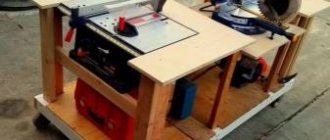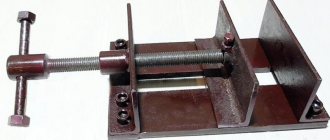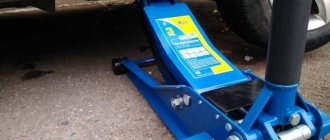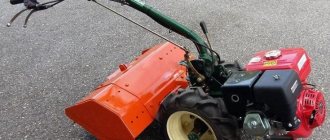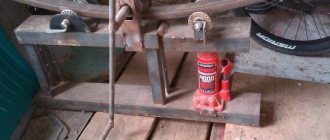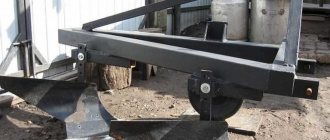If the main tools of a blacksmith are a hammer and an anvil, then for a carpenter there is nothing “more familiar” than his workbench. For people who work with wood, it can at the same time be a cutting platform and an assembly table, a stop and stand, a device for storing tools and even, if you want, a small carpentry machine, and sometimes a means of earning money. This article tells you how to make woodworking tables with your own hands. The instructions, photographs and drawings presented in it will help even a beginner to install this structure.
Osya member of FORUMHOUSE
First of all, after building a workshop, you need to make yourself a table. A table like a workbench, essentially. This is a table for work - fitting, assembling small things made of wood (stools, shelves, etc.). I'll call it an assembly table.
In fact, the second name for a workbench is an “assembly table.” But, as you already understand, its purpose goes far beyond assembly operations. Therefore, the design of a multifunctional workbench in a carpentry can be quite intricate (see drawing below), and its development (in the absence of experience) can be spent as much time as it takes to design the carpentry workshop itself.
Peculiarities
A folding workbench when folded takes up to 10 times less space than when working.
- Portable - a version whose operating principle is similar to a folding chair or a regular extendable table that is easy to carry. The disadvantage is the almost complete absence of drawers, which noticeably weigh down the structure: instead of them there are one or two shelves without back walls, the workbench itself resembles a rack.
- Universal - a structure that is attached to the wall, but unlike a regular wall-mounted table, this table has all four legs. The scheme is complicated by retractable wheels, allowing you to use the workbench as a cart. This version is reminiscent of a mobile table for preparing hot dogs, popular among fast food sellers in the 90s of the last century: there are shelves with back walls (or full-fledged drawers). It can be folded against the wall, lifted and secured, and rolled to another place. Carrying requires the help of two more people: the weight is significant - tens of kilograms.
- folding wall- mounted workbench is used in a home “office” or utility room – outside the home. It is stylized to match the general design of a home interior, and can be made as a mini-transformer, from the appearance of which guests will not immediately guess that this is a workbench. A profile pipe can be used for the underbench.
Podverstache
In the conditions of a large accumulation of individual cabinets, carpentry machines and additional accessories in the carpentry, it would be simply a crime not to use the free space under the workbench with maximum benefit for yourself. Therefore, creating a massive base (underbench) in the space under the upper plane of the workbench is a convenient technique that many craftsmen have long neglected when creating additional conveniences.
The fact of the matter is that in the design of a workbench, a lower shelf is absolutely necessary (especially on a mobile workbench). We use a lot of tools and have nowhere to put them outside while working. And it’s also inconvenient in the workshop - climbing back and forth on cabinets and shelves. Fold the same tool 10 times per hour.
The underbench can be adapted for storing power tools. For greater convenience, you can install cabinets and shelves here for small parts, fixtures and hand tools.
Having made a workbench that has all the listed elements, you can begin your carpentry activities. In the process of further work, you may need additional devices. But each master will be able to guess for himself what options to use and what elements to add.
You can learn how to properly dry wood, from which you can later make various products on your carpentry workbench, from our previous article. You can get acquainted with practical ideas regarding creating a carpentry workbench in the corresponding section of our forum. Any FORUMHOUSE visitor can become familiar with the rules and features of using a hand-held circular saw by visiting a special topic created for discussion.
Source
Types of workbenches depending on the type of work and available space
Taking into account exactly how the DIY workbench will be used in the garage, you need to select the desired configuration:
- landline or mobile;
- with a fixed, permanent tabletop, or folding;
- with additional shelves/drawers/holders and other storage places or simplified, in the form of a table;
- straight, angular or U-shaped;
- free-standing or mounted near a wall.
Since space is usually not enough, it is better to plan a stationary workbench with your own hands near the wall, and place it in a corner or in the least used place in the garage or workshop.
Important: if the room has windows or a ventilation outlet, a draft is possible - you should not place the workplace in its path, otherwise problems with the back, neck and muscles heated during work are guaranteed.
A mobile folding workbench, made with your own hands from scrap materials, can be kept anywhere, and can be pulled out to a suitable place during use.
Before selecting a specific model and choosing its dimensions, it is advisable to estimate the amount of equipment and tools you already have or are planning to purchase - it is better to make a workplace “for growth” than to suffer in trying to attach additional devices to already crowded shelves.
Folding workbenches:
Folding workbenches are portable (there will be photos below) and stationary, allowing you to effectively use a small space:
Interesting designs that combine a workbench and a storage system and are very compact when closed:
Combination of a workbench plus a wardrobe - a chest of drawers from the old Hammacher-Schlemmer company:
You can buy a plan with drawings and build your own version of this versatile and self-sufficient workplace:
When closed, it is a compact tall wooden chest of drawers; when open, there is a work area: a desktop workbench with a tray plus many drawers. Durable and compact, it's the perfect size for small to medium-sized woodworking jobs and many hobbies and crafts:
Video
: Lee Valley Apartment Workbench Plan
How and from what to make
The most affordable and practical material is wood and its derivatives. Plywood, chipboard, fibreboard, OSB, countertops from already unnecessary tables, etc. will be a completely reasonable choice.
It is important to consider:
- if work is carried out in a damp room, it is necessary to choose a material that is protected from moisture - laminated, impregnated, followed by varnish/paint treatment;
- the working surface should be as flat and smooth as possible. Using boards of different thickness/texture/treatment will not allow you to obtain such a surface, so for the tabletop it is better to use a solid slab of plywood or wood board;
- guides and racks should be made of the same type and size of material, except in cases where the load is distributed unevenly and some of the racks require reinforcement;
- connections of wood materials are made using fasteners (screws, bolts, screws, confirmations) and glue, as well as a tongue-and-groove or tongue-and-groove system. The adhesive type of connection requires waiting for the glue to dry completely; in critical places, it is better to duplicate the gluing with metal fasteners.
It is necessary to assemble a workbench in a wooden garage with your own hands in a fairly dry and well-ventilated room - dust from sawing and sanding materials, fumes from varnish/paint must be removed quickly.
Important: since the load on the tabletop is often very large and uneven - for example, only on one corner - it must be reinforced by a frame or supports located under the main plane.
How is it built?
workbench
is a completely wooden work table that has several basic elements:
- base (underbench);
- tabletop (lid);
- additional elements.
The main element is the tabletop. You should not use ordinary sheet materials - plywood or chipboard - for it, as they do not have sufficient strength and rigidity. The traditional way to test the reliability of a tabletop was to hit the surface with a mallet. Objects lying on it should not bounce. Sheet materials cannot provide this due to their small thickness, which creates excessive elasticity.
The tabletop of a classic workbench is glued together from wooden planks placed on edge. The thickness of such a shield is 6-8 cm. Tradition prescribes the use of beech or oak boards, but nowadays they have become difficult to find, and the cost of such a workbench will be too high, so you can get by with ordinary pine. Often the tabletop is assembled from two panels, leaving a longitudinal gap in the central part. It allows you to saw parts without resting them on the edge, but securely fixing the entire area on the supporting surface.
Important! When choosing boards for making a workbench, you need to pay attention to the quality and condition of the material. Wood that has not been tapped will constantly release resin, which will ruin the products being processed. An important selection criterion is also the degree of humidity.
The base of the workbench consists of two frame-type supports connected by two drawers. The supports are assembled as rigidly as possible into a tongue and groove with an adhesive connection. The drawbars are inserted into through sockets and fixed with wedges, which are periodically tapped to enhance strength. This method of assembly eliminates the workbench from loosening and ensures its immobility, regardless of workloads.
Additional items:
- vice;
- sockets for installing thrust wedges;
- tray for temporary placement of tools;
- additional shelf under the main tabletop.
A carpenter's workbench vice differs from a metalworker's in that the pressing surfaces are made of wood. The metal jaws of conventional tools crush the wood and damage the workpiece, while the wooden elements allow the part to be fixed without surface deformation. A classic workbench has two vices, front and rear. The first are located on the edge of the long side of the lid, the second - on the end. The stops are usually stored separately and inserted into the appropriate slots as needed. The tray is necessary for temporary placement of tools so that they do not fall on the floor. Adding an extra shelf is a more recent invention that was not used by everyone.
Other workbench designs are also used. There are samples whose lid does not differ from the classic one, and the base has one or two cabinets with doors and drawers. The result is a hybrid of a metalworking and carpentry workbench, convenient for small workshops. It must be taken into account that traditional workbench models were developed a long time ago, when hand tools were used for work. The shape and general structure of the lid is designed for the use of old, now little-known devices. Working methods have also changed, requiring appropriate organization of the workplace.
Important! The classic workbench design is designed for use only with hand tools. To use a power tool, such a cover must be upgraded, changed in size and configuration.
Recommendations
For clearer contact, the contact points between the parts are coated with wood glue. Strengthen glued joints using ready-made furniture corners or cut-off corner profiles. Strengthen corner joints where there is no contact with the drawers using triangular spacers.
It is advisable to immediately mount an extension cord with several sockets on the finished workbench - they will be needed to operate some power tools.
A folding workbench is hardly intended for heavy work such as assembling windows and doors. It makes turning operations difficult to produce massive parts weighing dozens of kilograms. For “heavy” work, it is better to assemble a stationary wooden workbench that can withstand a weight of more than one hundred kilograms.
- Regardless of how long the workbench is, it can be foldable (including a transformer). A one-room apartment or a small country house of 20-30 square meters is unlikely to allow you to place a stationary workbench that cannot be folded. Be guided primarily by the square footage of the living space. The same advice applies to an outside utility room or garage.
- Do not use plywood less than 15 mm thick or made from soft wood types for the tabletop. Such a workbench is only suitable for sewing work or activities that do not require the use of brute physical force.
- Do not work on a workbench with strong reagents, especially if there is frequent splashing. For chemically active work, special tables and stands, for example, made of glass, are used.
Compact semi-stationary workbenches
These workbenches have a base - legs to create a given working height of the table.
With two vices: front single-screw and side ones made of pipe clamps:
With convenient shelf and drawer:
The combination of a desktop workbench with sawhorses is quite convenient:
Assembling a workbench for the garage with your own hands
You can make a garage table with your own hands if you follow the basic recommendations. The whole process can be divided into just a few steps:
- The existing material is being cut. A pipe and a steel angle can be used to form a supporting structure. A garage workbench with a metal frame can withstand significant impact.
- In order for the mechanic’s workbench to have the required dimensions, it is necessary to change the dimensions according to the drawings.
- You can start work by making a power frame. To begin with, a load-bearing element is created, on which another load-bearing element is installed on top, onto which a steel sheet is fixed. You can weld a workbench yourself using a welding preparation.
- The load-bearing element is additionally reinforced with steel pipes. They act as stiffeners.
- The table for metalwork is installed on legs. This structural element is also welded to the base. The recommended length of the elements used is about 900 mm. Power jumpers are welded between the legs. They can significantly increase the rigidity and stability of the mechanism.
- After creating the supporting element, you can begin to create boxes in which tools and parts will be stored. A DIY garage table is made for specific tasks. The number of boxes and their sizes may vary significantly. To create this element, a steel pipe is used. The frame of the boxes is reinforced with a metal channel, which becomes stiffening ribs.
- The next step is to make a supporting frame that is suitable for creating a tabletop. The frame must be very strong, since it will bear a high load. Due to the use of a thick metal pipe, the workbench is durable and reliable.
- After creating the supporting structure, it is further strengthened. To do this, the brackets are welded to the sides. Holes are drilled in the middle of each bracket, which are used to attach the back and other walls.
- Boxes may have plywood walls. Due to this, the workbench becomes lighter. The sides are secured using self-tapping screws. It is recommended to create boxes of various sizes, thereby significantly expanding the functionality of the device. There are various options for the location of drawers on the Internet; the most suitable option is selected depending on your preferences.
- Holes are created on the inside of the structure to fix the guides along which the boxes will move.
- In this case, a board is used to make the table. It is placed on a previously prepared frame, where it is then fixed. Often a metal plate is placed on top of the wood planks to protect the wood from the elements.
- All seams should be thoroughly cleaned. A grinding machine and a file can be used for this. If there are untreated seams, there is a high risk of injury. When processing seams, problems may arise associated with the appearance of cracks and other defects.
- The surface of the wood used must be well sanded. This creates a flat surface that is ideal for placing the steel sheet. Wooden sheets must be fastened securely, otherwise, when a load is applied, the sheet will move or sag.
- Fastening the metal sheet should be done using hidden screws. This is due to the fact that welding work can cause the previously used wood to ignite. The sheet used must be painted on both sides, due to which the service life of the workbench is significantly increased.
- Recently, schemes that allow you to change the height of a certain part of the structure have become very popular. The height of the workbench in the garage is selected taking into account what kind of work will be carried out.
How to make: instructions
Let's consider the procedure for making a homemade workbench for carpentry using classical technology. The changes made to the design are minor and are intended to simplify and speed up the process. For convenience, we will divide it into stages that need to be described in more detail.
Base
To make the base, a frame is created from thick planks.
Sometimes they use timber, believing that it is much stronger and more reliable.
This is a misconception because solid wood is prone to warping and cracking.
The thicker the part, the stronger the internal stresses in it and the higher the likelihood of deformation. To increase the thickness, it is recommended to use a stack glued together from two or more boards, which stabilize each other and compensate for possible changes in shape.
To assemble, you will need to cut 4 parts for the legs, 4 parts for the upper and lower crossbars. 2 frame structures are assembled from them. The easiest way to connect elements is half-tree, when a layer of half the thickness is removed from a certain area of one part, and the same action is performed on another part. Then a layer of glue is applied to the resulting recesses, the parts are connected, the observance of the right angle is checked and the screed is performed with clamps.
In a similar way, 2 frame structures are assembled, which are then connected by drawers. They consist of two strips with a width of at least 100 mm. They can be connected to the legs either half-timbered or overlay using bolted connections. The main task is to maintain right angles and ensure parallelism of all parts.
Tabletop
To make a table top, you will need ties (wipes) or clamps with a large reach. The tabletop is glued together from planks 70-90 mm wide (usually edged boards are cut lengthwise) installed on edge. It is recommended to pre-plane the planks (waft) so that the gluing is as dense, strong and neat as possible.
Since boards with a thickness of 50 mm are used, after sharpening they will be slightly thinner - 46-48 mm. To set a panel 600 mm wide you will need about 13 planks. This is a lot, but a strong and immovable cover cannot be created from thin boards.
Important! You should not use plywood for the countertop. There are many recommendations online for gluing double-thick plywood sheets. Such a tabletop will flake, scratch the workpieces, and the craftsman will constantly have splinters. A cover made of planks is the best option.
The side (wide) sides of the planks are covered with an adhesive layer, pressed against each other and tightened with weaves or clamps. Ideally, after drying, the surfaces of the boards should be processed on stationary planing and thicknessing machines. If this is not possible, the surfaces are planed with an electric or manual plane and processed with a grinder. It is necessary to strive to create the most even plane possible.
It is not recommended to glue a wide 600 mm board at once; it is better to make two 300 mm halves and connect them with a technological gap that allows you to saw long parts directly on the table. The panels are connected using two or three strips attached to the bottom of the cover with screws. The thickness of the connecting elements should ensure the immobility of the halves, which is also enhanced when the cover is installed on the supports (cross members of the legs).
Video
We invite you to watch an interesting video on the topic.
Part 1:
Part 2:
How to make a stand for a drill?
Making a mini-drilling machine with your own hands does not require high qualifications, but it greatly expands the scope of application of an ordinary electric drill. In addition, the machine will be much cheaper than a purchased one, and components can be borrowed from previously used devices.
Making a wooden stand will take very little time and will not require any special materials or tools:
- wooden blocks or boards no thinner than 20 mm;
- furniture guides;
- metal rod with thread for caliper;
- fasteners for wooden parts (screws, glue);
- emery.
Tools:
- hacksaw;
- vice;
- Screwdriver Set;
- electric drill.
Making a stand from metal requires a little more time and materials, so it is necessary to cover it in a little more detail.
The proposed metal stand is more versatile than one made of wood and includes:
- supporting frame;
- guide posts of the drill, to which it is attached and moved vertically;
- vertical tool feed handle;
- additional components for ease of use.
What is the optimal height of a workbench for standing work?
The peculiarity of a carpenter's workbench is that the carpenter works with heavy material and uses many tools, such as:
- circular;
- milling cutter;
- clamps;
- vice;
- stops;
- sharpening machine;
- engraving devices;
- band saws.
Workbench dimensions
To increase stability, longitudinal and transverse supports are made.
The surface of the workbench is made of hardwood. Stationary options can be equipped with drawers, shelves, and mounts for storing tools. Mobile and folding imply only a working surface.
Standing corner product
To check how high a regular carpentry workbench should be for work, you need to stand sideways to the end of the table, lower your hand without straining. Place your palm on the surface. If the arm does not bend at the elbow joint, it means that the distance from the floor to the surface of the table top is ideal.
Workshop workbench
If you don’t have the money to buy a new carpentry workbench, you can purchase one that was decommissioned from a school workshop or make it yourself. But if a person’s height is more than 190 cm, then a school one will not be suitable, since its height is only 75 cm.
Tool cabinet in the garage
This bedside table will serve both for performing a variety of tasks and for storing tools. It will take up very little space in the garage, and if you try, its pleasing appearance will decorate the room.
- First you need to draw up a plan diagram of such a bedside table. You can choose the proposed option, or based on it you can design your own, taking into account all your personal wishes for the arrangement of the workplace.
- For a novice carpenter, it will be useful to build a bedside table for storing working tools. This will allow you to acquire the necessary experience in carpentry and build the mini-workshop necessary for full-fledged work, which will fit in a small wooden box.
- The proposed tool cabinet in this case is a small floor cabinet. Inside it is equipped with nests for storing various tools, and outside it has a workbench board. It is made from plywood boards or boards 20 mm thick. The bench board must be carefully trimmed and trimmed.
The tool cabinet is equipped with two drawers: one hinged on the door, the other pull-out - the number of drawers and their functionality can be any depending on your needs. The top of the bedside table is equipped with a hinged lid in the form of a drawer. The lid is attached to the frame with hinges. In the working position, it can be folded back and leaned against the wall, or it can be equipped with holders so that it independently remains in a given position. When not in use, the lid will simply lower and close the bedside table.
To make the frame of the bedside table, you need to use either bars or boards with a cross section of 1.5 X 2 cm. The product can be lined with plywood or wood board.
The device for keeping tools in the cabinet is made at your own discretion.
- As you can see in the photo, this garage furniture is either painted or covered with film. You can use a transparent finish, but this will require more painstaking carpentry preparation of the product.
- The interior decoration can be simple; it will be enough just to carefully and repeatedly sand the parts from the inside or paint them with varnish or light-colored paint.
- Materials for assembling a workbench. Total cost of the workbench.
- To assemble a workbench you will not need a lot of materials with a total cost of 3 to 3.5 thousand rubles, depending on the place of purchase. For reference, prices from the Leroy Merlin store in the Moscow region will be indicated.
Lumber
- Planed block 30x40x2000 needles - 1 pc. (68 rub.)
- Planed board 40x96x3000 needles - 5 pcs. (1610 rub.)
- Planed board 20x96x3000 needles - 4 pcs. (620 rub.)
- Layout 14x14x2100 needles - 1 pc. (70 rub.)
Fasteners
- Bolt with nut and two washers M8x100 - 16 pcs. (416 rub.)
- Drywall-wood screws 3.5x45 200 pcs. — 1 box (147 rub.)
- Drywall-wood screws 4.2x90 6 pcs. — 3 packs (42 RUR)
- Furniture dowel 10x50, wood, beige, 30 pcs. — 1 package (47 rub.)
- Reinforced mounting angle 40x40x40x1.5 - 4 pcs. (52 rub.)
- Waterproof PVA glue D3 Tytan 200 g - 1 bottle (151 RUR)
Universal machine height
Universal machines are an intermediate option between carpentry and metalworking. It is convenient for the garage, taking into account the minimal space for additional furniture. These tables are made of metal. They have a widened and elongated shape and can be adjusted.
Product with adjustment for standing work
Since the machine is universal, it is mainly equipped with mechanisms for changing the height of the tabletop. This is convenient, as you can adjust the height for different types of work relative to the equipment on the table.
You can purchase a support with 4 wheels for it, which will allow you to move the equipment indoors. There are folding models that include a lid with mounts for tools.
Home workshop
The optimal garage option is a folding universal workbench, which is mounted on the wall and has an additional wall panel for tools. The installation height can be calculated independently and attached according to individual parameters.
The standard sample is made of a wooden tabletop. However, it can be additionally equipped with a bracket, which makes installation and use easier.
Several product options
Materials and tools
As previously noted, if you wish, you can make a workbench with your own hands. The workbench can be made from a corner or from a profile pipe, it all depends on the specific drawing.
Necessary tools for assembly and processing of materials used:
- Level. In order for the work carried out to be accurate, the device must be positioned horizontally.
- Metal processing is performed with a standard grinder. This tool will also be needed for grinding the surface, for which it is enough to replace the disk.
- The connection of all elements is carried out using a welding machine. The welding seam is characterized by high rigidity and reliability. Today, welding is used extremely often, since many people can purchase a compact welding machine.
- A tape measure or rigid ruler can be used for measurement.
- It is important to observe all dimensions, since its stability and other performance qualities depend on the accuracy of the design.
- Some elements can be connected using a screwdriver. Metal screws are used for connections.
- In some cases, several sheets of plywood are required to create a workbench
- You can change the shape by using an electric jigsaw.
- A drill is also required to work with materials. It allows you to obtain the required holes in metal and wood.
The required materials are as follows:
The main material used is steel angle. The wall thickness should be 4 mm, due to which the structure is highly resistant to mechanical stress.
- Square pipe 60 mm by 40 mm. The thickness of the metal used is 2 mm.
- A corner that measures 40 mm by 40 mm.
- Steel strip with a thickness of 4 mm and the required size to create a tabletop.
- A steel sheet of small thickness, which is required to create the sides of the structure.
- Wooden boards to create a shelving unit.
- Plywood, which is used to create boxes.
- Screws for fixing detachable elements.
- High strength guides for drawers.
- Paint that is used to protect wood and metal.
After finding everything you need, you can begin the actual work. It is worth considering that the materials in question are suitable for creating a structure that is quite impressive in size.
Due to its large dimensions, a vice can be placed on one side of the bench and tools on the other.
Height of metalwork table
Product sizes are selected individually. In this case, the parameters of the room also matter.
Compact product
In small workshops they prefer to use a workbench due to its small dimensions.
In order not to make changes to the location later, it is installed in accordance with GOST requirements and must correspond to the standard height.
The following must be taken into account:
Wooden workbench
Schools and specialized educational institutions adhere to the same rules when teaching children in a professional direction. Since the bench machine does not require working with large parts, changing the height for different types of work is not required.
Construction of a carpentry workbench: design features
The simplest carpentry workbench consists of two elements: a workbench board (tabletop) and a workbench (a frame that performs a load-bearing function). A traditional workbench must be equipped with a vice. Depending on their placement, they can be front or end. Using a vice, wooden blanks are fixed in the required position.
Construction of a carpentry workbench: 1 – front clamp; 2 – rear clamp; 3 – screw; 4 – twists; 5 – tray; 6 – emphasis; 7 – sockets for wedges; 8 – wedges; 9 – front legs; 10 – hind legs; 11 – connections (2 pcs.); 12 – wedges (4 pcs.).
There are holes in the cover of the workshop table, as well as in the jaws of the vice, made of wood. They are used to install stops and clamps, which can have different heights and cross-sectional sizes.
Before work, the stops are set in a certain configuration so that the part can be placed between them in the required position. After the workpiece is installed, it is pressed using a screw mechanism that is equipped with a vice. This design allows you to securely fix the wooden part in a horizontal position.
The vice can be used to work with workpieces of different thicknesses. Specially for this purpose, stops of different heights are provided. The size of this element is selected so that during the processing of the part it does not protrude beyond the edge and does not interfere with the master.
The required components of the simplest workbench are a table top and a supporting frame.
Setting up the table saw and assembling the tabletop
- For the table saw, I cut and screwed 2 jumpers on which the saw body rests. I additionally reinforced this area with two vertical boards in the middle.
- I selected the height of the saw in such a way that after laying the table top it would be on the same level with it.
- I sewed up the bottom frame to turn it into a power tool rack. For this I used an OSB sheet, cut into 2 pieces 1200x1200 mm.
- Using the same OSB, I sewed up the top part - with a large piece I made a solid table top up to the saw, and with 2 small pieces I sewed up the space to the left and right of it.
